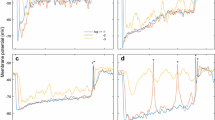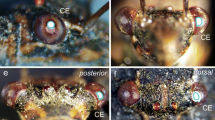Summary
The arrangement of first and second order neurons in an optic cartridge and the topographical relationships of the second order neurons within a cartridge and to groups of surrounding cartridges have been analyzed in the visual system of the bee, Apis mellifera, from light and electron microscope studies on Golgi preparations. At the level of the monopolar cell body layer, the nine retinula cell fibres of each ommatidium, the six short visual fibres arranged in a circle surrounding the three long visual fibres, become cartridges as a consequence of the appearance of the second order neurons (L-fibres) which join the R-fibre bundles. Two of the four different L-fibre types, L-1 and L-2, remain together in the centre of the cartridge throughout the lamina. The axons of the L-3 and L-4 fibres, however, have their position integrated into the circle formed by the endings of the short visual fibres. On the basis of further examination of light and especially electron microscopical Golgi material, the different L-fibres can be classified into four types which appear in each cartridge. The clear stratification in the first synaptic region (A, B and C) seems to be the best criterion for a morphological classification since such a classification necessarily also includes a functional basis. According to a naming system based on the position of the lateral processes, L-fibres with side branches in strata A, B and C are called L-1 fibres. Fibres with lateral processes in strata A and B are L-2 fibres; monopolar cell fibres with branches only in the second stratum B are L-fibres of type 3; and all monopolar cells with branches only in stratum C are called L-4 fibres. In addition to the branching pattern covering only the parent cartridge, two of the four fibre types (L-2 and L-4) have long collaterals reaching neighbouring cartridges: L-2 in stratum A and L-4 in stratum C. These collaterals presumably form a substrate for lateral interactions.
Similar content being viewed by others
References
Arnett, D.W.: Receptive field organization of units in the first optic ganglion of Diptera. Science 173, 929–931 (1971)
Arnett, D.W.: Spatial and temporal integration properties of units in the first optic ganglion of Dipterans. J. NeuroPhysiol. 35, 429–444 (1972)
Autrum, H.J., Zwehl, V.v.: Spektrale Empfindlichkeit einzelner Sehzellen des Bienenauges. Z. vergl. Physiol. 48, 357–384 (1964)
Boschek, C.B.: On the fine structure of the peripheral retina and lamina ganglionaris of the fly Musca domestica. Z. Zellforsch. 118, 369–409 (1971)
Braitenberg, V.: The anatomical substratum of the visual perception in flies. A sketch of the visual ganglia. In: Rendiconti S.I.F. XLIII (ed. by Reichardt, W.). London and New York: Academic Press 1969
Braitenberg, V., Debbage, P.: A regular net of reciprocal synapses in the visual system of the fly (Musca domestica). J. comp. Physiol. 90, 25–31 (1974)
Cajal, S.R., Sanchez, D.: Contribucion al conocimiento de los centros nerviosos de los insectos. Trab. Lab. Invest. Biol. Univ. Madrid 13, 1–168 (1915)
Meinertzhagen, I.A.: The first and second neural projections of the insect eye. Ph. D. Thesis, University of St Andrews (1971)
Menzel, R.: Spectral sensitivity of monopolar cells in the bee lamina. J. comp. Physiol. 93, 337–346 (1974)
Ribi, W.A.: Neurons in the first synaptic region of the bee, Apis mellifera. Cell Tiss. Res. 148, 277–286 (1974)
Ribi, W.A.: The neurons of the first optic ganglion of the bee, Apis mellifera. Advanc. Anatomy 50, 4, 1–43 (1975 a)
Ribi, W.A.: The organization of the lamina ganglionaris of the bee. Z. Naturforsch. 30c, 851–852 (1975c)
Ribi, W.A.: The first optic ganglion of the bee. I. Correlation between visual cell types and their terminals in the lamina and medulla. Cell Tiss. Res. 165, 103–111 (1975d)
Ribi, W.A.: A Golgi-electron microscope method for insect nervous tissue. Stain Technol. 51, 13–16 (1976)
Sommer, E.W., Wehner, R.: The retina-lamina projection in the visual system of the bee, Apis mellifera. Cell Tiss. Res. 163, 45–61 (1975)
Strausfeld, N.J., Braitenberg, V.: The compound eye of the fly (Musca domestica): connections between the cartridges of the lamina ganglionaris. Z. vergl. Physiol. 70, 95–104 (1970)
Strausfeld, N.J., Campos-Ortega, J.A.: The L-4 monopolar neuron: A substrate for lateral interaction in the visual system of the fly (Musca domestica L.). Brain Res. 59, 97–117 (1973)
Trujillo-Cenoz, O.: Some aspects of the structural organization of the intermediate retina of Dipterans. J. Ultrastruct. Res. 13, 1–33 (1965)
Varela, F.G.: Fine structure of the visual system of the honeybee (Apis mellifera). II. The lamina. J. Ultrastruct. Res. 31, 178–194 (1970)
Zettler, F., Järvilehto, M.: Lateral inhibition in an insect eye. Z. vergl. Physiol. 76, 233–244 (1972)
Author information
Authors and Affiliations
Rights and permissions
About this article
Cite this article
Ribi, W.A. The first optic ganglion of the bee. Cell Tissue Res. 171, 359–373 (1976). https://doi.org/10.1007/BF00224660
Received:
Accepted:
Issue Date:
DOI: https://doi.org/10.1007/BF00224660




